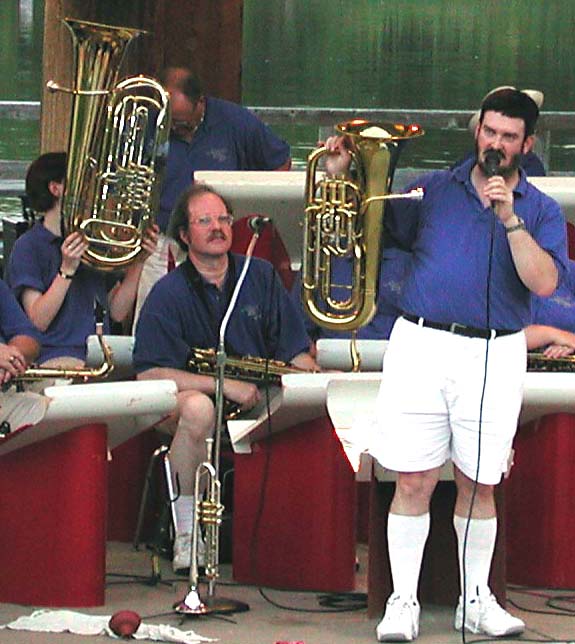
For the August 1, 2000, Roseville Big Band concert, Carin Bratlie played tuba on several selections and Glen Newton played euphonium on several choruses of "Two O'Clock Jump".
In this photo, Carin holds up and her tuba and Glen holds up his euphonium so the audience can see the similarities and differences.
Tenor saxophonist Glen Peterson, in the middle, looks on approvingly.

In case you couldn't tell from the photo, here's a rundown on the similarities and differences:
Conical Brass. The tuba and euphonium are both members of the conical brass family, generally referred to as the "tuba family". In fact, the euphonium is often called a tenor tuba. Thus you may think of the tuba as being the big sister of the euphonium (or the euphonium being the little brother of the tuba), if you like to anthropomorphize musical instruments.
Pitch and Tubing Length. Both of these instruments are pitched in B-flat. This means that the series of notes that can be played without using the valves starts on B-flat. Since the tuba has twice the length of tubing as the euphonium, its fundamental (lowest) B-flat is an octave lower than that of the euphonium. The fingerings for the two instruments are the same, except for the octave difference. B-flat is the standard key for euphoniums in the United States, but tubas in other keys - especially C and E-flat - are common.
| Valves. |  |
Glen's euphonium has piston valves. Most euphoniums in the United States have piston valves. (Note that three valves are together, played with the right hand, and there's a fourth valve halfway down the left side, played with the left hand. An alternate configuration for a four-valve euphonium has all four valves together, to be played by the four fingers of the right hand.) | In contrast, Carin's tuba has rotary valves. Both rotary and piston valves are common on tubas in the United States. | 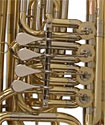 |
| Bell Location. | 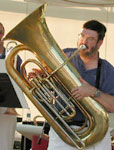 |
When the instrument is being played, the bell on Glen's euphonium faces the right side, as seen by the player, and he puts his right hand through the middle of the instrument to reach the valves. Some piston valve tubas, such as the one Glen is playing in this photo at Centennial Lakes Park, are made this way, as well. | 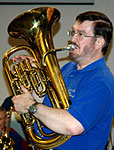 |
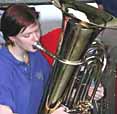 |
However, rotary valve tubas like Carin's and some piston valve tubas are made with the bell facing the left. To play it, Carin reaches her right hand around the right side of the tuba to the valve levers on the front, while her left hand helps support the instrument. |
Euphonium vs. Baritone. In many respects, the euphonium is the same as the baritone horns played in American wind bands (that is, bands that include both brass and woodwinds), such as the Roseville Community Band. The difference is a subtle one having to do with the diameter of the tubing (smaller on the baritone horn). The euphonium and baritone horn are pitched the same, co-exist in the same section of the wind band, and play the same music, with their players using the same technique.
In contrast, brass bands around the world, including the Lake Wobegon Brass Band and Salvation Army bands in the Twin Cities area and the Sheldon Theatre Brass Band in Red Wing, Minnesota, generally include the euphonium but not the American baritone horn. They use the euphonium as an ensemble member and a rich-sounding baritone-range solo instrument, with a smaller-bore instrument of the same pitch providing two harmony parts. Terminology for this other instrument varies throughout the world, but in the United States, outside of the brass band context, it is called the tenor horn or English-bore baritone to distinguish it from the American baritone horn played in wind bands. Within a brass band, this smaller-bore instrument is called a baritone horn. Glen sometimes plays his tenor horn as a solo instrument in Roseville Big Band concerts.
Where Can I See Them? In the Twin Cities, the best opportunity to see a wide variety of tuba-family instruments is at the annual TubaChristmas concerts conducted by Carol Jensen. They've been held at Central Presbyterian Church in St. Paul in recent years. Roseville Big Band director Glen Newton (alternating between tuba and euphonium) and former member Jim Foster (playing his euphonium) are frequent participants in these concerts.